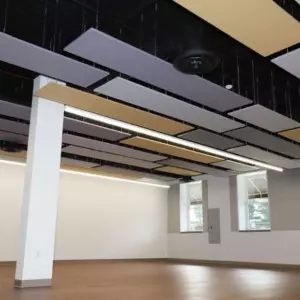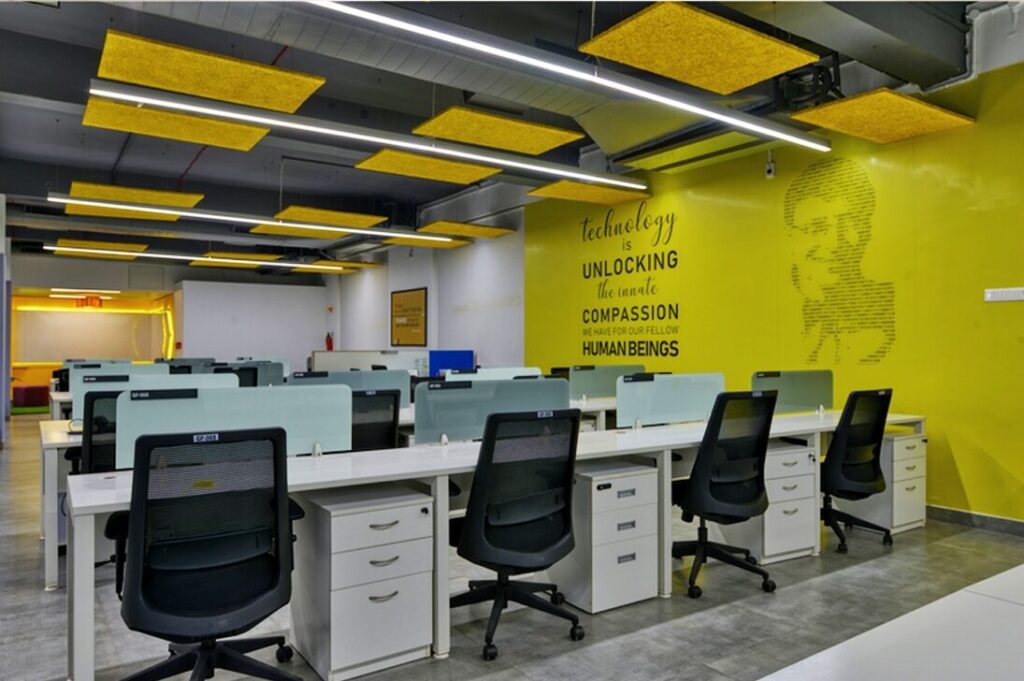Acoustic Panels for Meeting Rooms
1. Introduction
In any meeting, the ability to clearly communicate and comprehend is of utmost importance. Unfortunately, conventional meeting rooms often have hard surfaces that cause sound waves to bounce around, resulting in a chaotic auditory environment. Acoustic panels for meeting rooms offer a practical solution by reducing echo and reverberation, thereby improving speech intelligibility and overall sound quality. These panels are specifically designed to absorb sound energy and minimize sound reflections, creating a more conducive environment for productive meetings.

2. Functionality of Acoustic Panels for Meeting rooms
Acoustic panels are engineered to absorb sound waves, preventing them from bouncing back into the room. They consist of porous materials, such as foam or fabric, which effectively trap sound energy. As sound waves pass through the panels, the materials convert the acoustic energy into heat, significantly reducing sound reflections. This absorption process helps to mitigate echo and reverberation, resulting in a clearer and more focused sound.
3. Advantages of using Acoustic Panels for Meeting rooms
3.1 Improved Speech Intelligibility
One of the primary advantages of using acoustic panels in meeting rooms is the improvement in speech intelligibility. By reducing echo and reverberation, these panels ensure that spoken words are clearly heard and understood by all participants. This enhances communication, minimizes misunderstandings, and fosters more effective collaboration.
3.2 Enhanced Privacy and Confidentiality
Meeting rooms often host discussions on sensitive topics or confidential matters. Acoustic panels help maintain privacy by reducing the transmission of sound outside the room. They prevent sound leakage and create a more secure environment for confidential discussions.
3.3 Noise Reduction
External noise can be a significant distraction during meetings. Acoustic panels provide effective noise reduction by absorbing and attenuating external sounds. This helps
maintain a peaceful and focused atmosphere within the meeting room, enabling participants to concentrate on the agenda at hand.
3.4 Aesthetically Pleasing
Acoustic panels come in various designs, colors, and patterns, allowing for customization to suit the aesthetics of any meeting room. They can be seamlessly integrated into the existing décor, enhancing the overall visual appeal of the space while serving their functional purpose.
3.5 Increased Comfort and Well-being
By reducing excessive noise and creating a more comfortable acoustic environment, acoustic panels contribute to the well-being of meeting participants. A quieter and more pleasant space promotes better concentration, reduces stress levels, and ultimately enhances the overall meeting experience.
4. Factors to Consider When Choosing Acoustic Panels for Meeting rooms

When selecting acoustic panels for meeting rooms, it is essential to consider several factors to ensure optimal performance and compatibility with the space. Here are some key considerations:
4.1 Acoustic Properties
Different types of acoustic panels have varying absorption coefficients and frequency ranges. Understanding the specific acoustic requirements of your meeting room will help you choose panels that address the room’s unique sound characteristics.
4.2 Size and Thickness
The size and thickness of acoustic panels can impact their absorption capabilities. Thicker panels generally provide better low-frequency absorption, while larger panels offer broader coverage. Assess the dimensions of your meeting room and choose panels accordingly.
4.3 Installation Flexibility
Consider the installation options available for acoustic panels. Some panels can be mounted on walls, while others can be suspended from ceilings or placed as freestanding elements. Evaluate the room layout and select panels that can be installed conveniently without obstructing the space.
4.4 Fire Safety Standards
Ensure that the selected acoustic panels comply with fire safety regulations. Look for panels that have been tested and certified for their fire-resistant properties, providing peace of mind and maintaining safety standards within the meeting room.
4.5 Budgetary Constraints
Acoustic panels are available in various price ranges, depending on the material, design, and manufacturer. Define your budgetary limits and explore options that offer the best balance between performance and affordability.
5. Installation and Placement of Acoustic Panels for Meeting rooms
Proper installation and strategic placement of acoustic panels are crucial to their effectiveness. Here are some guidelines to consider:
5.1 Wall Mounting
When mounting acoustic panels on walls, identify areas with high sound reflection and place the panels accordingly. Pay attention to the height and spacing between the panels to achieve optimal sound absorption. Experimenting with different arrangements can help fine-tune the acoustic performance.
5.2 Ceiling Suspension
For larger meeting rooms or spaces with limited wall surfaces, suspending acoustic panels from the ceiling can be a practical solution. This installation method ensures maximum coverage and absorption, especially in rooms with high ceilings.
5.3 Freestanding Panels
In some cases, freestanding panels can be used to create partition walls or portable sound barriers within the meeting room. These panels offer flexibility in terms of placement and can be rearranged as per the changing requirements of the space.
6. Maintenance – Acoustic Panels for Meeting rooms
To maintain the performance and longevity of acoustic panels, regular maintenance is essential. Here are some maintenance tips to follow:
6.1 Dust Removal
Regularly dust off the panels using a soft brush or a vacuum cleaner with a brush attachment. This prevents the accumulation of dust and maintains the panel’s sound absorption capabilities.
6.2 Stain Removal
In the case of fabric-covered panels, treat any stains promptly using mild cleaning solutions recommended by the manufacturer. Avoid using harsh chemicals that may damage the fabric or compromise the panel’s acoustic properties.
6.3 Inspection and Replacement
Periodically inspect the panels for any signs of damage, such as tears, sagging, or disintegration. Damaged panels should be replaced promptly to ensure continued optimal performance.
7. The Role of Acoustic Panels in Enhancing Communication
Effective communication is the cornerstone of successful meetings. Acoustic panels play a vital role in creating an environment that fosters clear and uninterrupted communication. Here’s how they contribute:
7.1 Clarity and Intelligibility
By reducing echo and reverberation, acoustic panels improve speech clarity and intelligibility. Participants can hear and understand each other more easily, facilitating meaningful and productive discussions.
7.2 Reduced Distractions
External noise can be a major distraction during meetings. Acoustic panels minimize noise interference, allowing participants to focus on the agenda without being disturbed by extraneous sounds.
7.3 Active Listening
In a well-acoustically-treated meeting room, participants can actively listen to one another, picking up on nuances and subtle cues. This fosters better comprehension, collaboration, and decision-making.
7.4 Confidence and Engagement
When participants can clearly hear and be heard, they feel more confident in expressing their ideas and opinions. This promotes active engagement, encourages participation, and cultivates a more inclusive meeting culture.
8. Creating a Productive Meeting Environment – Acoustic Panels for Meeting rooms
Beyond their acoustic benefits, acoustic panels contribute to creating a productive meeting environment in various ways:
8.1 Privacy and Focus
Acoustic panels help maintain privacy within the meeting room, preventing sound leakage and ensuring confidentiality. They also create a focused atmosphere by minimizing external distractions, allowing participants to concentrate on the meeting agenda.
8.2 Comfort and Well-being
A comfortable and pleasant meeting environment positively impacts participants’ well-being, reducing stress levels and promoting concentration. Acoustic panels contribute to a more peaceful and soothing ambiance, enhancing overall comfort during meetings.
8.3 Professional Image
Investing in acoustic panels demonstrates a commitment to professionalism and attention to detail. A well-designed and acoustically-treated meeting room reflects positively on the organization, leaving a lasting impression on clients, partners, and employees.
8.4 Productivity and Efficiency
By eliminating sound-related barriers, acoustic panels enable smoother communication, faster decision-making, and increased productivity. Meetings held in an optimized acoustic environment tend to be more efficient, resulting in time savings and improved outcomes.
9. Design Considerations – Acoustic Panels for Meeting rooms
While the primary purpose of acoustic panels is to enhance sound quality, their design should also complement the overall aesthetics of the meeting room. Consider the following design considerations:
9.1 Material and Finish
Acoustic panels are available in various materials, including fabric, foam, wood, and metal. Choose a material that aligns with the room’s design concept and complements other elements, such as furniture, lighting, and color schemes.
9.2 Color and Pattern
Opt for acoustic panels that offer color and pattern options. This allows for customization to match the room’s color palette and design theme. The panels can blend harmoniously with the surroundings or create an eye-catching focal point, depending on the desired visual effect.
9.3 Shape and Texture
Consider different shapes and textures available in acoustic panels. Some panels have unique designs, such as geometric patterns or 3D formations, adding depth and visual interest to the meeting room. Evaluate the space and choose panels that enhance its overall aesthetics.
10. Aesthetic Impact of Acoustic Panels for Meeting rooms
Contrary to common belief, integrating acoustic panels into meeting room design does not compromise aesthetics. In fact, these panels can enhance the overall visual appeal of the space. Here’s how:
10.1 Seamless Integration
Modern acoustic panels are designed to seamlessly integrate into different architectural styles and interior designs. They can be custom-made to match existing wall colors, textures, or finishes, blending in effortlessly with the room’s aesthetics.
10.2 Artistic Possibilities
Some acoustic panels offer opportunities for artistic expression. Manufacturers provide a wide range of design options, including printed patterns, artwork, or even corporate branding. These panels serve as functional art pieces, adding a unique touch to the meeting room while serving their acoustic purpose.
10.3 Accentuating Design Elements
Acoustic panels can be strategically placed to accentuate specific design elements in the meeting room. For example, panels can be arranged to highlight architectural features, create visual symmetry, or draw attention to focal points within the space.
11. Eco-Friendly Solution – Acoustic Panels for Meeting rooms
In an era of increasing environmental consciousness, acoustic panels offer an eco-friendly solution for meeting room acoustics. Here’s why:
11.1 Sustainable Materials
Many manufacturers now produce acoustic panels using sustainable and recyclable materials. These panels contribute to reducing environmental impact and align with green building practices.
11.2 Energy Efficiency
Acoustic panels enhance energy efficiency by optimizing the acoustic performance of meeting rooms. With reduced echo and reverberation, less energy is wasted on unnecessary sound reflections, resulting in a more efficient use of resources.
11.3 Indoor Air Quality
Certain acoustic panels are designed to improve indoor air quality. They are made with low-emitting materials that minimize the release of harmful pollutants, creating a healthier and more pleasant environment for meeting attendees.
12. Cost Considerations – Acoustic Panels for Meeting rooms
When considering acoustic panels for meeting rooms, it’s essential to evaluate the cost implications. Here are some cost considerations:
12.1 Quality and Performance
Investing in high-quality acoustic panels ensures better performance and durability. While premium panels may have a higher upfront cost, they offer long-term benefits in terms of sound control, maintenance, and longevity.
12.2 Customization and Branding
Customizing acoustic panels to match the room’s design or incorporate branding elements may incur additional costs. Consider the value of visual cohesion and brand representation when assessing the overall budget.
12.3 Installation and Expertise
The installation of acoustic panels may require professional expertise, especially for complex configurations or ceiling suspensions. Factor in installation costs and consult with acoustic specialists to ensure proper placement and optimal results.
12.4 Return on Investment
Consider the long-term benefits of acoustic panels, such as improved productivity, enhanced communication, and a positive meeting experience. These intangible advantages can contribute to a significant return on investment over time.
13. Exploring Different Types of Acoustic Panels for Meeting rooms
Acoustic panels come in various types, each designed to address specific acoustic needs. Here are some commonly used types of acoustic panels:
13.1 Fabric-Wrapped Panels
Fabric-wrapped panels consist of a sound-absorbing core covered with an acoustically transparent fabric. They are versatile, customizable, and offer a wide range of design options. Fabric-wrapped panels are suitable for various meeting room sizes and aesthetics.
13.2 Foam Panels
Foam panels are lightweight and cost-effective options for meeting rooms. They are made from open-cell foam that efficiently absorbs sound waves. Foam panels are easy to install and offer good overall acoustic performance.
13.3 Wooden Panels
Wooden panels add a touch of natural warmth to meeting rooms while providing effective sound absorption. These panels are typically made from perforated or slotted wood, allowing sound to pass through and be absorbed by the underlying acoustic material.
13.4 Resonance Panels
Resonance panels are designed to address specific low-frequency resonance issues. They consist of thin panels that vibrate sympathetically with sound waves, effectively reducing the impact of resonant frequencies within the meeting room.
13.5 Diffusion Panels
Diffusion panels scatter sound waves in different directions, breaking up sound reflections and creating a more balanced acoustic environment. They are useful in larger meeting rooms or spaces with complex architectural features.
Conclusion – Acoustic Panels for Meeting Rooms
Acoustic panels play a crucial role in optimizing meeting room acoustics, enhancing communication, and creating a productive and comfortable environment. By reducing echo, reverberation, and external noise, these panels improve speech clarity, focus, and engagement. They also contribute to the overall aesthetics of the space, with customizable options that seamlessly integrate into the room’s design.
Consider the acoustic properties, installation flexibility, maintenance requirements, and budgetary constraints when selecting acoustic panels for your meeting room. With careful planning and the right choice of panels, you can transform your meeting room into a harmonious and effective space that fosters collaboration, creativity, and successful meetings.
Frequently Asked Question- Acoustic Panels for Meeting Rooms
1. How do acoustic panels work?
Answer: Acoustic panels work by absorbing sound waves, reducing echo, reverberation, and external noise. They are designed to optimize the acoustics of a room, improving speech clarity and creating a more comfortable and focused environment.
2. Can acoustic panels be installed on ceilings?
Answer: Yes, acoustic panels can be installed on ceilings. Ceiling-mounted panels provide maximum coverage and absorption, making them suitable for larger meeting rooms or spaces with limited wall surfaces.
3. Do acoustic panels require maintenance?
Answer: Yes, acoustic panels require regular maintenance to ensure optimal performance. Dusting off the panels and promptly treating any stains or damages are essential for maintaining their sound absorption capabilities.
4. Can acoustic panels be customized to match the room’s design?
Answer: Yes, many acoustic panels can be customized to match the room’s design. They are available in various materials, colors, patterns, and even with options for printed artwork or branding.
5. What is the lifespan of acoustic panels?
Answer: The lifespan of acoustic panels depends on their quality, maintenance, and usage. With proper care, high-quality panels can last for many years, providing long-term benefits for the meeting room acoustics.
Other Acoustic Panels Products

PU Foam Acoustic Panels

Wood Wool Acoustic Board

Pet Polyester Acoustic Panel
Contact Us
Mobile: +919008400701 / 705
Email: sales@jayswalgroup.com

Visit Us
Address:
#6, 10th B Cross, Jayswal Center, KHB Main Road, Kaveri Nagar, Kanakanagar, RT Nagar, Bangalore – 560032, Karnataka, India.
Other Websites: